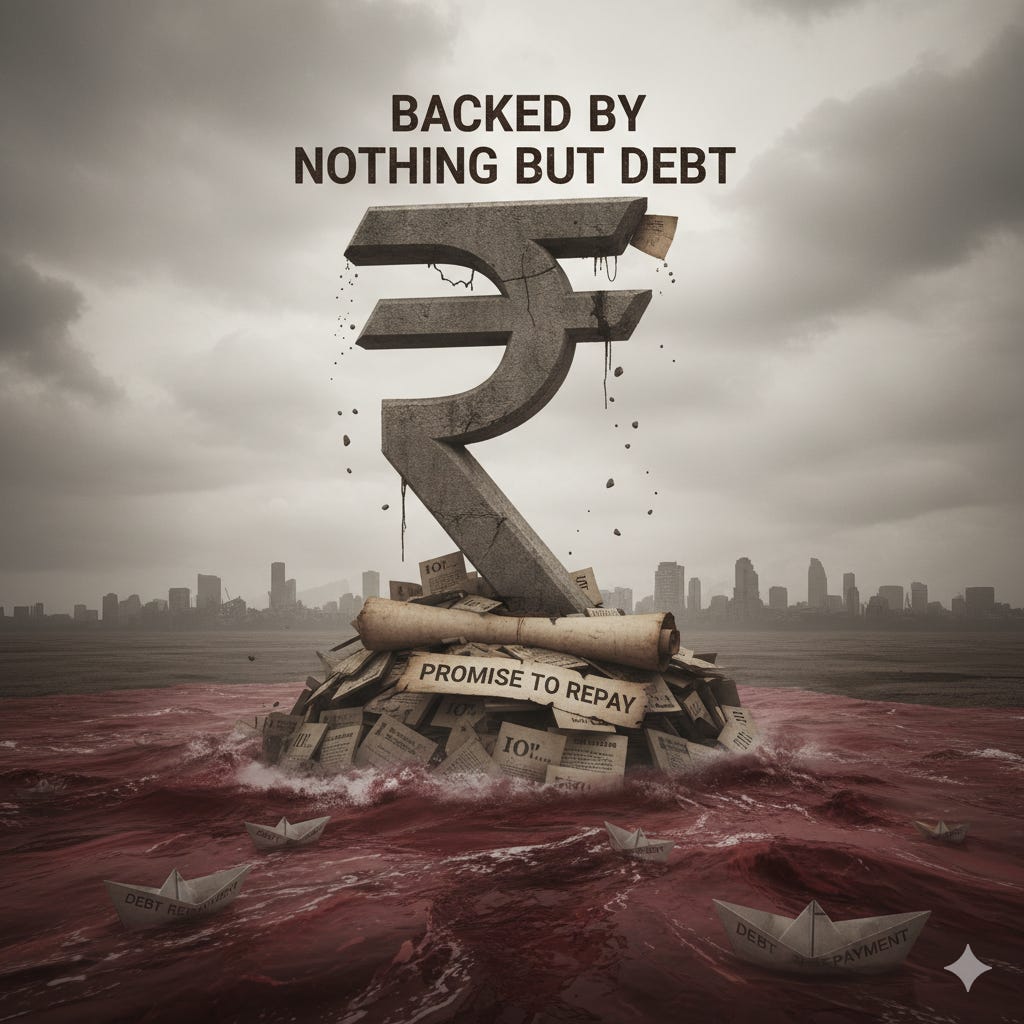The Truth About the Indian Rupee: Backed by Nothing But Debt
How Debt, Not Gold, Powers the Indian Rupee and Shapes Wealth in Modern India.
A lot of people still believe that the Indian rupee is backed by something tangible - like gold, silver, or some other asset. Some assume that the Reserve Bank of India has piles of gold sitting in vaults that guarantee the value of every rupee note. But the truth is far less comforting: the Indian rupee is not backed by gold or any physical asset.
The Indian rupee, like almost every modern fiat currency, is backed by nothing more than debt - specifically, the promise to repay debt. This may sound strange at first, but once you understand how money is created in today’s financial system, it starts to make sense.
How Money Is Created Through Debt
Let’s start with a simple example.
Imagine someone deposits ₹10 lakh of their savings into a bank. The bank doesn’t just keep that ₹10 lakh sitting in a locker. Thanks to what is called the fractional reserve system, the bank is required to keep only a small fraction of that money aside (say 10%, assuming the cash reserve ratio is 10%). The rest can be loaned out.
So, the bank lends out ₹9 lakh to someone who wants to buy a car. The car dealership that receives this ₹9 lakh then deposits it into their own bank account. Now, that bank treats the ₹9 lakh as fresh deposits, keeps 10% (₹90,000), and lends out the remaining ₹8.1 lakh.
This cycle keeps repeating. Each time money is deposited, a new loan is created, and fresh deposits appear in the system. After about 10 such cycles, the original ₹10 lakh deposit has multiplied into nearly ₹1 crore of circulating money in the economy.
But here’s the catch: this expansion only continues as long as people are borrowing and staying in debt. If people start repaying their loans, the process reverses. That ₹1 crore of circulating money eventually collapses back toward the original ₹10 lakh.
In other words, money exists in the economy only because people are in debt. The “promise to repay” is the real backing behind the rupee - and behind all modern money.
What Happens in a Crisis?
Now let’s think about what happens during a crisis like COVID or a recession.
When the economy slows down, people don’t borrow as much. They may even start defaulting on their loans. When one person defaults, the bank that lent them money suffers a loss. That bank, in turn, might fail to meet obligations to others. This creates a domino effect where insolvency spreads through the financial system.
Unlike repaying debt (which slowly shrinks money supply), defaults can destroy money very quickly. The “floating money” in the system evaporates, and suddenly there’s much less money circulating. This is what creates deflationary pressure in a recession. And with less money circulating, businesses shut down, jobs are lost, and people struggle to even meet basic needs.
This is why recessions feel like wealth destruction on a massive scale—because they literally are.
How Governments Respond
Governments and central banks know how painful recessions are. They know that if defaults cascade unchecked, unemployment, hunger, and social unrest will rise. So, they intervene.
But here’s the problem: in a recession, ordinary people can’t take on more loans. Salaries are low, jobs are uncertain, and credit scores are weak. Since the entire system depends on ever-expanding debt, someone else must step in to borrow.
And that “someone” is usually the government and large corporations.
Governments borrow money (by issuing bonds) and then spend it into the economy. Central banks often cut interest rates or even print new money to make borrowing easier. Big corporations also take on cheap debt. This way, the cycle of debt expansion continues, and the money supply keeps growing.
On the surface, this looks like a rescue. In reality, it simply shifts the burden. Instead of ordinary citizens borrowing, the government borrows on their behalf - and future taxpayers will foot the bill.
Who Wins and Who Loses
This system of financial engineering creates a strange kind of modern slavery.
Asset holders (those who own real estate, stocks, gold, or businesses) are protected. As the money supply expands, the value of their assets generally rises, shielding them from inflation.
Wage earners (those living paycheck to paycheck) are punished. The price of essentials - food, rent, fuel - keeps rising faster than their salaries. They pay the cost of keeping the system alive, often without even realizing it.
In this way, debt-based money ensures that wealth keeps concentrating at the top, while ordinary people struggle harder each year to maintain the same standard of living.
What makes this system particularly insidious is that no one feels guilty. Asset holders don’t consciously think they are enslaving others. Wage earners don’t see the invisible chains of debt and inflation. But the system continues, silently creating winners and losers.
The Reality of Modern Money
So, what is the Indian rupee really backed by? Not gold. Not silver. Not oil. It is backed by debt - the collective promise of individuals, businesses, and governments to keep borrowing and repaying.
This system can keep running for decades, even centuries, as long as confidence remains. But it is not without cost. The hidden cost is inequality, instability, and the quiet suffering of those at the bottom of the economic ladder.
Understanding this truth is the first step in protecting yourself. The second step is to decide which side of the equation you want to be on: the side that owns assets or the side that rents them.
Because in the modern financial system, money is debt - and debt is power.



Informative. Insightful.